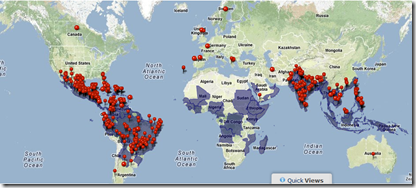# 6702
While not reaching the levels we saw during their 2010 Dengue epidemic, Puerto Rico is once again seeing epidemic levels of the mosquito-borne virus, as evidenced by this latest chart from the CDC.
As indicated by the red line, the number of cases over the past couple of weeks has been climbing like a homesick angel.
Health Secretary Lorenzo Gonzalez of the Puerto Rico Health Department declared a Dengue epidemic on the island (PDF Link – in Spanish) in early October after six people died or the disease, two of them children.
This week, Florida also reported its third locally acquired Dengue case (see Another Central Florida dengue case confirmed) of 2012. This latest case was identified in Osceola County, and a fourth suspected case is being investigated.
While once a serious problem in Florida, through aggressive mosquito control efforts during the 1940s Dengue and Malaria were both eliminated from the Sunshine State – and remained so for nearly a half century.
In 2009 – for the first time in more than 50 years – we started to see a small number of locally acquired Dengue cases showing up in Key West (see MMWR: Dengue Fever In Key West), and in 2010 they totaled 65 cases in Key West and 1 each in Broward and Miami-Dade County.
The number of cases dropped in 2011, and have been low once again in 2012.
The concern is - with millions of visitors arriving each year, many from regions where these diseases are endemic – there are plenty of opportunities to re-introduce the virus.
The CDC’s MMWR in a report in May of 2010 on Locally Acquired Dengue in Key West, had this to say:
Cases of dengue in returning U.S. travelers have increased steadily during the past 20 years (8). Dengue is now the leading cause of acute febrile illness in U.S. travelers returning from the Caribbean, South America, and Asia (9).
Many of these travelers are still viremic upon return to the United States and potentially capable of introducing dengue virus into a community with competent mosquito vectors.
In truth, it may take many such introductions of Dengue or Malaria to an area before the right combination of weather, insect vectors, and ongoing transmission occur to enable it to get a foothold in a community.
But Florida’s latest Arbovirus Surveillance report lists more than 90 cases of Imported Dengue this year:
Ninety-four cases of dengue with onset in 2012 have been reported in individuals with travel history to a dengue endemic country in the two weeks prior to onset. Countries of origin were Brazil, Colombia, Cuba (21), Dominican Republic (9), Ecuador (4), El Salvador (2), Ghana, Guyana (2), Haiti (14), Honduras, India, Jamaica (17), Mexico (2), Nicaragua, Panama, Philippines, Puerto Rico (6), South Africa, Sri Lanka, St. Vincent, Suriname, Trinidad (4), and Turks & Caicos.
Counties reporting cases were Brevard (3), Broward (17), Collier, Duval (2), Hillsborough (4), Lee (2), Marion, Miami-Dade (36), Orange (12), Palm Beach (6), Pinellas (2), Polk, Sarasota (2), Seminole (3), and Volusia (2). Nine of the cases were reported in non-Florida residents.
The state has also reported more than 50 cases of Imported Malaria, although no locally acquired cases have been reported.
Fifty-three imported cases of malaria with onset in 2012 have been reported. Countries of origin were: Afghanistan (2), Cameroon, Central African Republic, Colombia, Costa Rica, Ethiopia, Ghana (5), Guyana (2), Haiti (9), Honduras (3), India, Ivory Coast (3), Kenya, Liberia (2), Nigeria (8), Pakistan, Peru, Sierra Leone (2), South Africa, Sub Saharan Africa, Sudan, Togo, Uganda, Zambia, and multiple African countries (2).
Counties reporting cases were: Alachua, Brevard, Broward (8), Charlotte, Duval (6), Hillsborough (6), Lake (2), Leon, Manatee, Marion, Martin, Miami-Dade (7), Orange (5), Osceola (2), Palm Beach (4), Pinellas (3), Polk, Seminole, and Volusia. Five of the cases were reported in non-Florida residents.
A broader perspective comes from PAHO, who's Oct 31st update shows nearly 1 million cases of Dengue in the Americas this year.
An interactive map view of Dengue activity in the Americas, and around the world, can be seen via the CDC-Healthmap collaborative DengueMap.
Although the overall risk of contracting a mosquito-borne illness in Florida or Puerto Rico remains very small, reports of Dengue (along with West Nile, EEE, SLEV, and other rare arboviral threats) are reason enough that health departments continue to urge people to remember to follow the `5 D’s’:



